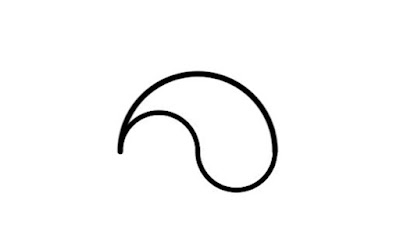The Guardian today posted three very difficult math problems selected from the archives of Pythagoras magazine.
One puzzle asks you to divide the shape above into two identical shapes. I suppose a trivial answer would be to divide it in the plane on which it exists, but there must be a more elegant solution.
Then there is the Dollar Bill problem:
In a bag are 26 bills. If you take out 20 bills from the bag at random, you have at least one 1-dollar bill, two 2-dollar bills, and five 5-dollar bills. How much money was in the bag?And a Huge Pie problem:
A huge pie is divided among 100 guests. The first guest gets 1% of the pie. The second guest gets 2% of the remaining part. The third guest gets 3% of the rest, etc. The last guest gets 100% of the last part. Who gets the biggest piece?The last one could be solved by brute force, but a proper answer requires a mathematical explanation.
I don't have answers for you; unless readers post solutions in the Comments, you'll need to go to The Guardian.

Solved the first puzzle. Hint: first divide the shape into two PAIRS of identical shapes (i.e. two of one shape and two of another), ignoring chirality. Then move/rotate/reflect the shapes in such a way that they merge like jigsaw puzzle pieces into the two larger shapes that you need.
ReplyDeleteThat's enough for tonight.
The first one ain't too hard. Think swastikas :)
ReplyDeleteI thought the second one was pretty obvious... Just think how many five dollar bills there have to be for this to work. And how many two dollar bills. And how many one dollar bills...
ReplyDeleteSolution in Rot-13:
ng yrnfg ryrira svirf (bgurejvfr vg jbhyq or cbffvoyr sbe fvk gb or yrsg bire va gur ont, yrnivat hf jvgu yrff guna svir). sbe gur fnzr ernfba, ng yrnfg rvtug gjbf naq frira barf. guvf gbgnyf gb gjraglfvk ovyyf, fb gurer ner friraglrvtug qbyynef va gur ont.
Rot-13 explained:
Deletehttps://en.wikipedia.org/wiki/ROT13
The third one is a little trickier but it can be solved as follows:
ReplyDeleteSolution in Rot-13:
Gur svefg bar trgf bar uhaqerqgu bs gur pnxr. Gur frpbaq bar trgf avaraglavar ol bar uhaqerq gvzrf gjb ol bar uhaqerq. Vs jr pner ba, gur a-gu thrfg trgf a ol uhaqerq gvzrf (uhaqerq zvahf a cyhf bar) ol (a zvahf bar) gvzrf jung gur cerivbhf thrfg tbg. Fb nf ybat nf gung nqqvgvbany snpgbe vf terngre guna bar, ur trgf zber guna gur ynfg bar. Fvzcyvslvat gur rdhngvba yrnqf gb a fdhnerq yrff guna gjbuhaqerq. Gur ynfg a gb shysvyy gung vf sbhegrra, fb gur sbhegrragu thrfg trgf gur znkvzhz.
I did an Excel spreadsheet, and it looks like the 10th person gets the biggest piece (6.28+)?
DeleteRot-13 decryptor:
Deletehttp://www.decode.org/
Or http://www.rot13.com/ ... take your pick.
DeleteOriginal solution here: First of all, sorry about all the encryption mess. Second, other Anonymous guy, I get the same as you when I write it down. I made a rather obvious mistake: I took "whatever the last guy got" instead of "running total" so to speak. Guess I can't go to bed yet after all. ;)
DeleteActually no, it's fine. I just botched the simplification. I did +100 at one point instead of +n. It simplifies to n(n-1)>100, so n>11. So n=10 is the last guest with a positive factor, so it's 10. Quod erat demonstrandum!
DeleteIf you plot the Excel results, you get an interesting curve.
Deleterot-13 decoder: http://www.decode.org/ you do learn something new every day
ReplyDeleteIf y'all are interested in cryptographic codes (such as ROT-13, but also way more advanced stuff) and the history of making/cracking them, Simon Singh's The Code Book is a definite must-read.
Deleteexcellent book!
DeleteI-)
Or, for the historically interested, David Kahn's Codebreakers.
Deletesolutions are online :
ReplyDeletehttps://www.theguardian.com/science/2017/jun/19/did-you-solve-it-pythagorass-best-puzzles